#dnd worldbuilding
Text
A Workshop for Creating Magical/ Fictional Crystals: A Guide from a Geologist
Hi folks, its me, here to talk about fictional writing again! Today I'm just tackling the idea of magical stones/mana stones by looking at existing minerals today and some neat properties that they have, and how you can apply these things to a fictional world. The goal is mainly to help you if you are stuck trying to come up with a unique magic system, or a unique identification/characteristic of your mineral.
First Things First: Mineral Shapes

I am exhausted, petered out, down-right fatigued by seeing every mineral depicted with having the crystal structure of calcite and quartz. There are soooooo many cooler, more interesting crystal structures, don't you think you would stop and take a look at a perfect cube in nature? It is completely unsettling.
Second: Color
Color within minerals can either be really important, or not important at all! It is your choice to decide if color is going to be something that means something to your mineral. But what are some times when the color is important? Well.... there are some elements that are called chromophores, this classification just indicates that these elements, when present, will determine the color of whatever they are in. So, if you wanted to treat mana like a chromophore, you could say, "Oh everything that contains mana turns green!" This could mean that regardless of the mineral, if that mineral is a specific color, it means it contains mana. This concept is exciting because you can just stop here and use minerals that already exist! You can also use it as an indicator for a magical ore! Chromophores are typically metals, so if you are making a new metal weapon, making the ore of that metal a unique color would make a lot of sense!
However, your mineral can also just be every color of the rainbow like quartz and perhaps that's what makes identifying your mana stones elusive and create an illusion of scarcity that your character can solve.

There are other things that can change the colors of minerals, like radiation damage, and electron exchange, but I think that is beyond what would be helpful! So lets talk about some unique color properties that happen in nature that seem magical in the first place! Maybe you don't need to design a mana stone, but you want a unique gemstone that only the royal family passes down or something (IDK).
The first one is the alexandrite effect! This is where a mineral can change color in natural light vs. incandescent light. (the mineral itself is not changing, but the lights contain different amounts of different colors that then get absorbed by the stone). Even if you don't use electricity in your fictional world, you could have the colors change in the presence of light magic. This could create fun misunderstandings about what the mineral is reacting to!
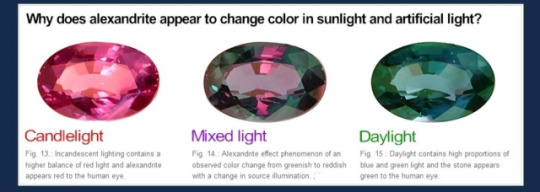
Pleochroism
Pleochroism is something that most minerals have, it is frequently used to help identify minerals in thin sections, however minerals are usually not pleochroic enough for it to be visible to the naked eye! Pleochroism is just a fancy name to describe the change in how light is absorbed based on the angle of the mineral! So if you scroll up to the first image where I showed a lot of crystal shapes, most of them have angles where they are longer and shorter! This will effect the way light travels in the crystal. Tanzanite is a popular mineral that does this.

Photochromism
This is when a mineral will change color (in a reversible way) when exposed to UV light (or sunlight), I am not going to go too into the details of why this is happening because it would require me to read some research papers and I just don't feel like it. The mineral that is best known for this is Hackmanite!

Alright! These are all the really cool color effects that might inspire you or maybe not, but now I am going to talk about how you might find your minerals within a rock!
When I see a lot of magical caves/mines, typically I see them with some variation of a geode honestly, but most minerals are not found like that! Now I am sure most of you guys have seen a geode, so I will not really talk about those, but I will talk briefly about porphyroblasts which is when the mineral grows larger than the minerals around it, this happens in metamorphic minerals!

sorry random stranger, but this is an image of garnets inside a finer-grained rock at gore mountain in New York!
Another way you might find minerals is in a pegmatite! This is when all minerals are really large! This is a formed from really slow crystalizing magma!
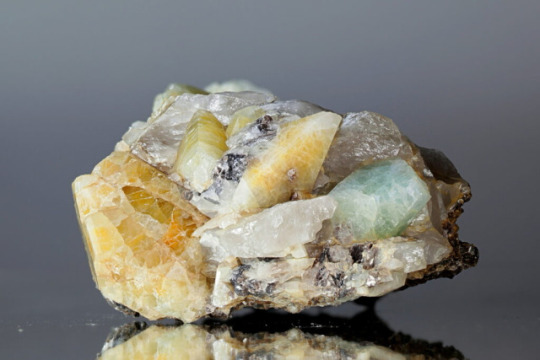

But something else to think about is that your mineral might just be massive, it doesn't have to have distinct crystals, it may be similar to jadeite where small grains grow together which leaves it looking smooth and seamless! A note about all of these is that you would have to mine into the rock to find these, there would not be any natural caves in these rocks! Caves are only ever really formed in limestones and maybe marbles (rocks that react with acid).

How can your characters identify these minerals?
Typically when you are out in the field you will look to see what type of rocks the minerals are found in (The overall texture of the rock will tell you how it formed). If you know how the rock formed, it will narrow down the amount of minerals you need to think about by quite a bit! Next, you are going to look closely at it and observe its crystal structure, does it have an obvious crystal? if so what is the general shape? If it is broken, how did it break? Did it fracture like glass or did it break along uniform planes. Some minerals have a thing called cleavage (breaks along planes of weakness). If a mineral exhibits this habit, it will again help narrow this down. Next we can look at color. Color can be misleading, because minerals like quartz can be any color imaginable, but minerals like olivine will always be green! The next thing your character can do is test for hardness, minerals all have a specific hardness that can help identify it as well.
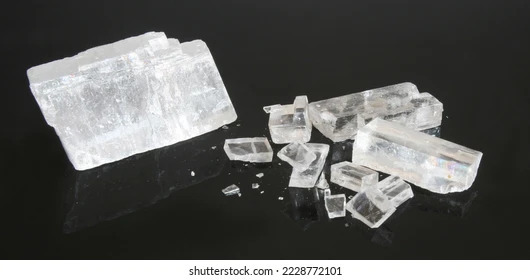
After you go through all of this, your mineral might have some special property! This could be magnetism, fluorescence, reactions to acid, or any of the color changing effects I mentioned above! Other than that, your character can take it back to a lab and do a number of things to identify it, but the most typical thing would be for them to make a thin section (very thin piece of the rock) and observe it under a cross polarized microscope!

On that note folks! I hope this helped in some way in thinking of new magic mineral properties! I have other guides that explore some different fictional worldbuilding issues you might run into, but if you have any topics you would like me to cover please that I haven't mentioned already, let me know!
#geology#rocks#creative writing#fictional world#worldbuilding#dnd#dnd worldbuilding#worldbuilding stuff#writing resources#info post#information#writing
4K notes
·
View notes
Text
hey, pspspspsps. you play D&D? you dm?
consider a settlement of elves and dwarves sharing each end of a giant tree. because that's what i just came up with
i know hardly anything about D&D so i pass this over to y'all. seemed like a cool concept. please credit me if you end up using it though!!
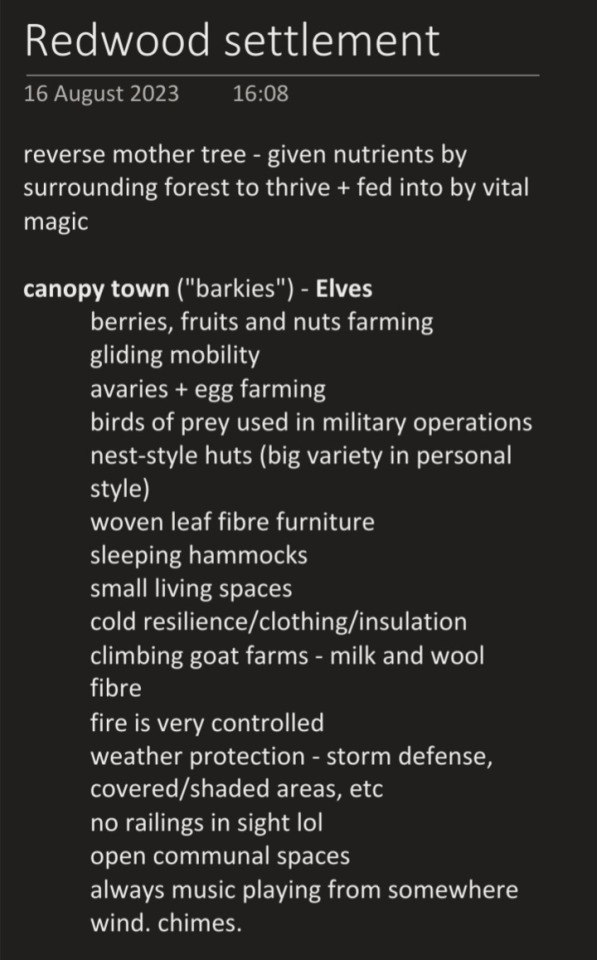

gonna start calling dwarves tubers. lil root veggie lads <3
also research deck prisms!!! they're really cool!!!
#dnd#dungeons and dragons#dnd concept#dnd worldbuilding#dnd ideas#dungeon master#dnd location#dnd dwarf#dnd elf#dnd dwarves are still grubby lil miner guys right#that hate elves? right?
531 notes
·
View notes
Text



Maheshwari Indian Temple
Tall marble staircases, ornate pillars, and a golden-brass statue all welcome worshippers and travelers to the Maheshwari Mandir, which roughly translates to "Temple of the Great One."
Indian temples come in a variety of styles, but the inner structures are almost always the same. There are two main sections, an inner chamber that houses the deity called the garba griha, and an outer worshipping space called the mandala. Worship typically takes place in the form of a Puja, during which various food items are offered to the deity in a large sacrificial fire.
This map can also be used as a general fantasy temple if you wish to do so.
Download the map for free here.
This map will also be included as part in my 5e Devabhumi setting book, which will be released this year! Devabhumi is an Ancient India-inspired campaign setting, which presents an alternate world that brings the epics and stories of this rich culture to life.
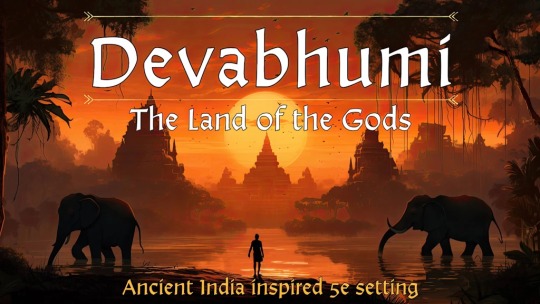
#dnd maps#battlemaps#battlemap#d&d#dnd#pathfinder#tabletop#ttrpg#cartography#dndart#fantasy map#rpgmap#5e#dnd worldbuilding#dungeon master#unearthed arcana#dnd homebrew
74 notes
·
View notes
Text
been thinking reaaally hard about the tritons on mana. i’m making things up as i go but damnit this is fun (yes they’re naked. i didn’t want to bother covering them up with clothes. and i wanted to show off the markings n stuff. but realistically they would wear clothes.)
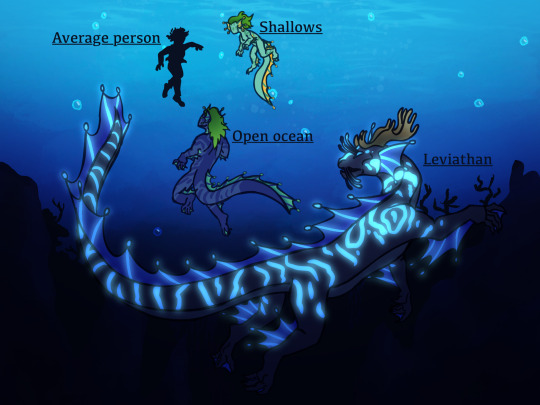
BASICALLY the idea i have is that a very long time ago tritons were split up into three main groups, the ones who live in the shallows, the ones who live in the open ocean, and the ones that live in the deepest depths available. (details, of which there are many, under the cut. oh and additional versions of the drawing) (do take a look if you can, i wrote a lot)
the shallows variant, living near islands in shallow kelp forests and in coral reefs (sometimes even inland lakes and rivers), were the smallest. a bit shorter than the average human, in fact. they came in bright green-blue colors with a vibrant and diverse array of brightly colored fins, webbing, and gills. they were also the most humanoid.
those in the open ocean lived just about wherever as long as it wasn’t too deep or too near the oversea, and were bigger than humans. averaging well over ten feet in height, and nearly double that if you include the tail. they came in darker blues accented with green, often mirroring the deep blues of their environment. they are most defined, however, by their slightly uncanny features. they lean a bit more towards fishiness than their little cousins.
and in the deepest, furthest reaches of the ocean, where hardly any sunlight reaches at all, are the biggest, and least humanoid breed of triton. they’ve gone by many names, colossals, poseidons, leviathan tritons, you get the idea. coming in dull blues and purples, but with dazzling displays in the form of bioluminescent markings, along with coral-like horns or antlers growing from their heads, suggesting draconic influence in centuries past. they are enormous, so big in fact, that because i’m not great at eyeballing measurements i’m leaving it up to the concept art i’ve done to show off just how big they are. once upon a time, they lived among the leviathans, oceanic gods of their time, truly colossal in nature. but they were just as advanced and intelligent as their relatives. they were also the earliest tritons, from which the rest are descended.
now, the leviathan tritons are gone. whether something killed them or if they simply vanished, it’s impossible to know for certain. but the two surviving variants put aside their differences and became one, and now modern tritons sit comfortably between the appearances of both their ancestors. and as for what remains of the leviathan variant? well, it’s less obvious, but some bloodlines of modern tritons still carry those magnificent flashing spots and stripes, and on occasion, an infant is born with budding, brightly colored horns that grow with them as they develop and age.
these horns are generally thought of as a sign of powerful magic, or of godly influence. it can skip generations, but is passed down nonetheless.
here are the unshaded version, and the sketch, of the drawing seen above (oh and. i completely forgot to give the Big Tritons hair. as an excuse let’s say this is a bald one, but they’d normally also have hair.)


#jrwi riptide#just roll with it#dungeons and dragons#dnd triton#dnd worldbuilding#things i said#things i drew
229 notes
·
View notes
Text

Jocelyn Lena's mindscape is the first of many Penny and Junebug will traverse in Mind or Matter. An idyllic solarpunk world of bright sun and institutes of learning, something darker lurks beneath the surface, which the duo will uncover together!
This is concept art for my currently in pre-production webcomic Mind Or Matter! If you are interested in seeing more, please give the blog a follow to keep up to date on progress!
#concept art#fantasy art#solarpunk#worldbuilding#dnd#dungeons and dragons#dnd worldbuilding#solarpunk art#fantasy world#fantasy worldbuilding#watercolor#digital watercolor#art#my art#artists on tumblr
143 notes
·
View notes
Text
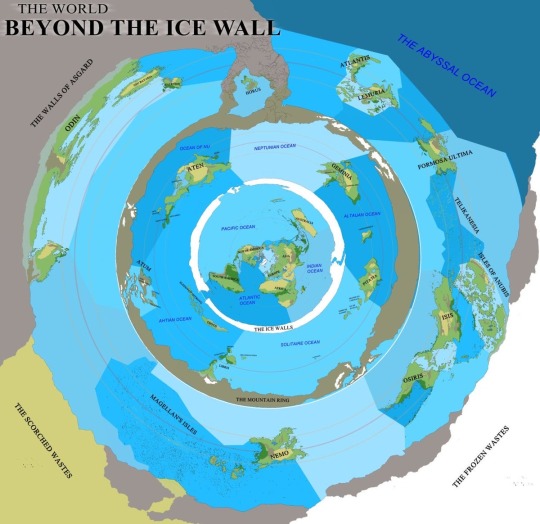
Flat earther worldbuilding goes way too hard
146 notes
·
View notes
Text
"Drow skin became darker because they lived underground for so long": lame, boring, unoriginal, makes literally no sense
"Drow skin became darker as a defense mechanism so they could camouflage better in the predator filled caverns of the Underdark": brilliant, amazing, genius, unquestionable, makes absolute sense
#dnd#dungeons and dragons#dnd drow#drow#dnd thoughts#their hair is white so it standing out can attract prey#or their eyes could be glowy#like deep sea fish#i feel like a genius for this ngl#dnd worldbuilding
324 notes
·
View notes
Text



Some more deities from my homebrew dnd setting. These are known as the elemental elder gods and have been involved in some big lore drops recently.
In my setting, there are 20 triangular artifacts like the faces of a d20 bound to 20 planes: 16 outer planes and 4 elemental planes. These deities are the first stewards of the elemental planes' faces.
Ontogwi was given stewardship of the face of water. They decided not to touch or use the domain, and because he is its first steward, no one else can claim it without him touching it first. Despite this, he still grants divine magic to her followers, powers of healing, moonlight, and water bending. Ontogwites also don't believe in death as a concept.
Karadris was given stewardship of the face of air. Then she fucking ate it >:)
Doshaera was given stewardship of the face of earth. To prevent others from claiming the domain, she broke it into many pieces and scattered it across the world, hidden deep underground. Eventually, its shards started making their way into dwarven vaults and dragon lairs.
Thalaar was given stewardship of the face of fire. Being prideful, he displayed his artifact in the light of the sun, where it was sealed for millennia before a group of adventurers in the fire plane managed to bring it down, immediately leading to a fight over who should have it. It was claimed by the vampire Nauron.
Om nom
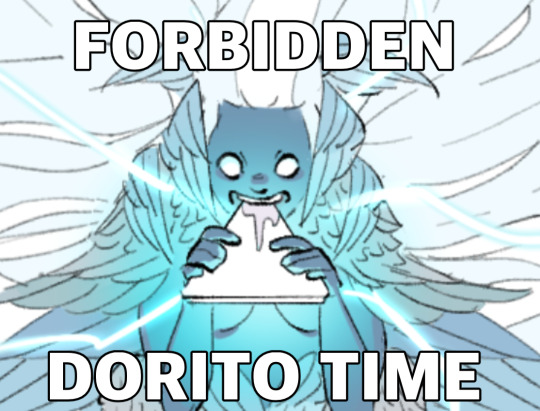
my players are probably wondering how the Crimson Coven acquired this tasty triangle ^
#dnd#art#dungeons and dragons#dnd deity#worldbuilding#dnd worldbuilding#character design#digital art#drawing#clip studio paint#d&d#why does my worldbuilding sound like something out of elden ring??#this lore is from 2016 with very minor adjustments since
15 notes
·
View notes
Text
I'm so in love with consequential magic.
Give me arcana that feels alive, living and breathing and dangerous. Give me magic that will consume you if you aren't careful to train. I want to see battle mages carefully maintaining how much magic they've channeled so it doesn't burn them. I want ambitious wizards who unknowingly let their magic eat them alive. I want scarring that leaves the bearer unable to cast magic from a spell that was too powerful for them to handle. I want good magic users to border on ethereal and succumbing to the arcane because the human body wasn't built to handle such forces but insist on bending them to their will.
24 notes
·
View notes
Text
Geology of Natural Disasters and How to write them into your fictional universe.
So, you want to write about a natural disaster to advance your plot and torture your players/characters even more? Let me tell you how, accurately.
I feel like unless it is a volcano, natural disasters are a pretty slept on plot drivers, and some of them are really cool and unique! Today, I will talk to you about land slides, earthquakes (And earthquake related disasters), and volcanoes.
Landslides: Probably one I see the least in stories, but one that would be incredibly interesting to write into a plot where they believe in curses. Landslides can happen along ocean bluffs, slightly hilly areas, and highly mountainous areas, this means it is something that can happen in most landscapes. But what can trigger a landslide? Mostly all you need to trigger a landslide could be just abnormally large amounts of rain, excessive deforestation (with a little bit of rain), or an earthquake. If you don't want to use deforestation or an earthquake as a catalyst, a really cool indicator that the land is slipping and may be prone to a collapse is J hooked trees.

This indicates that there is soil creeping slowly over time, and it may lead to a major landslide.
2. Earthquakes: Probably one of the easiest things to write, earthquakes can happen anywhere, but they are most common in places that are tectonically active areas. There are about three types of environments you can expect earthquakes to be common. The first is just rugged mountains, if your landscape looks like this, you should write in earthquakes. Associated hazards could be landslides, avalanches, and large falling rocks.
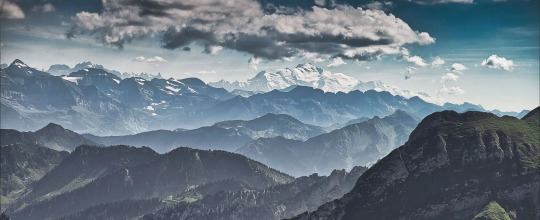
The next landscape could be a thin mountain range, next to the ocean, very scenic, but very dangerous. Essentially, I am describing a subduction zone environment.

Earthquakes in these areas could equal a couple different associated disasters. Scenario one: A very large earthquake happens, and the ocean begins to recede. This is a tsunami, enough said. If you are writing a tsunami though, please, please, do not write it as a large wave, thank you. Also, a common way people are hurt by tsunami's are from them going into the ocean because they don't understand a tsunami is going to happen.
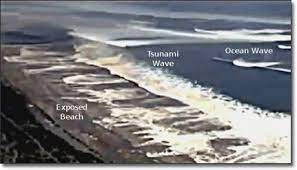
Scenario two: A large earthquake happens, your characters are in a valley and suddenly the ground begins to liquify as the ground shakes, once the shaking stops, the ground becomes solid like nothing ever happened, except everything has suddenly sunk into the now hard ground. This is called liquefaction and it typically happens in areas that have loose dirt or lots of saturated soil.
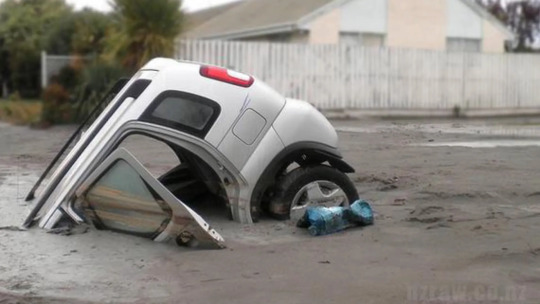
Scenario three: There are a lot of small earthquakes, they do not cause a lot of damage, but you begin to notice that one of the isolated mountains has a plume rising. Earthquakes can indicate lava moving underground and the filling of magma chambers.
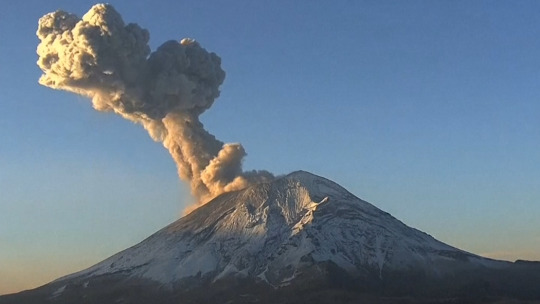
The next environment that can host lots of earthquakes would be regions that have a lot of really deep valleys and small mountain ranges (not cone volcanoes), but overall seems pretty flat.
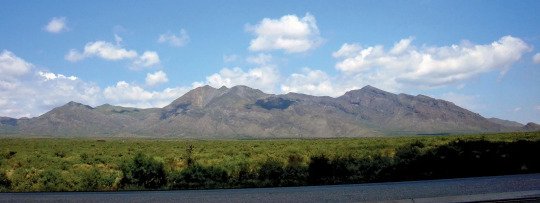
This indicates a transform fault like the San Andreas. If you want to hint at there being earthquakes in the area, you can show fence posts that are suddenly several feet out of line at a dilapidated farm or something similar.
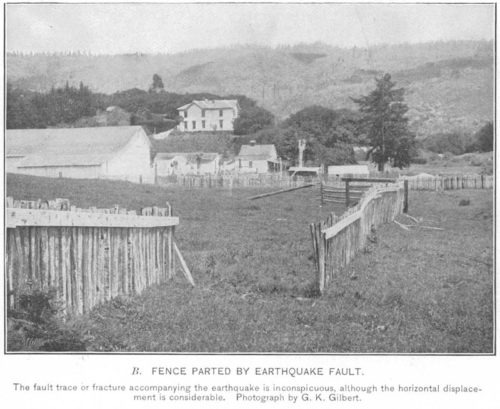
(These earthquakes are different because they are cased from sideways movement, not an up-and-down movement this hint can only be used for this environment). Volcanoes would not be found here, but liquefaction and landslides could still occur here.
4. Volcanoes: If you thought earthquakes had a lot of information, volcanoes do too. First you have to ask yourself, what kind of volcano you want to have, what kind of eruption style? So lets break down the kind of eruptions you can have and what their landscapes look like. Hawaiian Shield volcano: This will produce a smooth fast lava, the landscape typically is pretty flat, but there will be small cones and the rocks can have a ropey or jagged texture and the rocks will be almost exclusively black to dark red.

Stratovolcanoes: These will be solitary mountains, typically, that look like perfect cones (Picture shown in earthquake section). These will have large ash cloud eruptions and pyroclastic flows, they may have some lava, but typically most damage is done from the pyroclastic flows (think Pompeii). Some hints of these, other than describing the cone features (which can be hidden by other mountains), would be to talk about petrified wood! Trees can get fossilized in the ash and I imagine it would be very strange to find this rock that clearly looks to be a piece of wood, but its a rock. Subcategory- Calderas: Used to be a large stratovolcano, but they erupt so explosively that the entire cone collapses and creates a basin.

There are a lot of kinds of volcanoes out there, so forgive me for just putting an infographic and then talking to you about these really rare types of eruptions that I feel like people should know about.
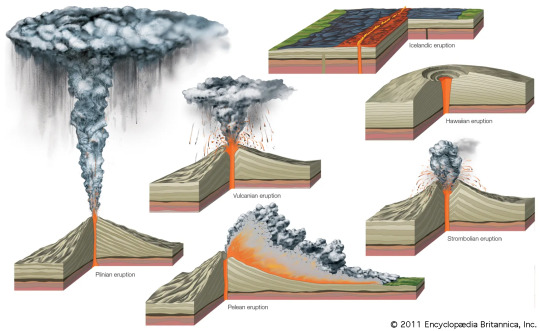
Okay lets talk about blue lava (kind of) and black lava

You will notice the lava is still red in the middle of this image, during the day these would look like a normal eruption, but at night the burning sulfur would make it appear blue. Some cool features other than this, would be that any water in the area would become very acidic and burn the skin due to sulfuric acid. This would again be really cool if you are trying to describe a 'cursed' land.
Black lava: This happens only in the east African rift I believe, but it is a carbonatite lava, but if you are writing in a rift valley (where the continent is tearing apart to form a new ocean) this might be a cool feature. The lava will cool white and will quickly erode, it makes for a very alien landscape!

Anyway as always, this is supposed to be an introductive guide for the basics of writing geology to create cool landscapes/features into dnd or fictional universes, if you are a geologist please understand my oversimplification of tectonics, I didn't want people to run away.
#geology#rocks#stem#dnd#dnd worldbuilding#worldbuilding stuff#fictional world#worldbuilding#fictional writing#writing resources#creative writing
4K notes
·
View notes
Text
audly’s favourite (free) d&d resources
d&d books are really expensive. for beginners, that can be daunting if trying to get into playing. some people are under the impression that you have to have all the books (or at least one or two) to be a good dm or player.
so i’m here to compile my favourite resources!
5etools
literally my favourite. it has sections divided by what you’re looking for, and a super easy filtering system. it’s got stuff from most books (except the critical roll ones) and dm screen resources! also has the ua (unearthed arcana) playtest materials.
D&D wiki
also has pretty much everything! not really divided by books (as far as i can find), which may make it a bit tricky. but if you know what you’re doing, you’re set. especially helpful for spells.
Fantasy Name Generators
in my opinion, naming things is one of the hardest things to do. like you’ve got this cool axe weapon thing that glows but you don’t want to just call it the “glowy axe”. or a super badass elf character that has a pet raccoon. or a city where your campaign will be. so you go through your brain for a good name and it’s empty. names give things meaning and importance. choosing one is hard. if the name generator doesn’t give you a name, it should at least get the ball rolling. they have one for pretty much everything.
Roll20
basically a dnd specific discord! you can host games, display maps, and have access to all your player’s sheets in one place. i find this one a lil tricky to navigate without a mouse, but i’ve managed with just my trackpad. roll20 also has a fairly extensive compilation of resources like class descriptions, weapons, etc. etc. i use it a lot when making magic items and worldbuilding.
DnD Disability
all about incorporating disabilities into dnd! i really enjoy this site. they offer some creative mechanics for varieties of neurodivergence, chronic pain, and mobility aids. a super amazing resource to make your game more accessible.
Hero Forge
great for making character designs and has the option to buy a 3d print of your mini. some of the race options are little limiting (read: i tried to make a pigeon aarakocra out of a ravenfolk and it did not work), but overall is functional.
D&D Beyond
at this point i think everyone and their mother has heard of D&D beyond. it’s essentially the “official” dnd site, with all the official content and boundless homebrew. it has a character creator option too, which is useful for people who need some extra support. the issue is that it exists behind a paywall. if you want to add anything other than the “standard” options or use someone else’s homebrew in your game, you have to buy a membership. you can browse homebrew just fine without one, but can’t put it on your character sheet. for all it’s costly negatives, i do find joy in the unhinged and unbalanced home made things people conjure. worth at least looking at.
Pinterest
great for character and setting inspiration! also has some homebrew monsters, items, and weapons which can be meh. if you’re looking for nifty mechanics, pinterest may be your place as well. i have seen both phenomenally cool things i’ve incorporated into my games and the Most Questionable Things Ever.
Arcane Eye
more of a blog, but does contain exceptionally useful knowledge. much like roll20, arcane eye has resources that can inform you as a player or dm. they have guides to different things.
D&D Compendium
it sure is a compendium! it’s got the whole kitten caboodle, “how to dm” and “how to play” sections if you need some extra help, map tools, and a bunch of other how-to’s. they have links to other dnd resource sites as well, so if you can’t get it on the compendium, you can get it from one of those. you can also network and find a group to play with via the compendium. (but be careful with strangers from the internet, said the stranger from the internet.)
The Official D&D Site
has a bunch of free pdfs for character sheets and whatnot, as well as some pre-generated characters and basic rules. they don’t have a huge amount of content for free, but who can blame them with all the pirated content out there.
donjon
so many free generators. a dm’s best friend. they have map makers for dungeons, towns, npc’s, etc. so much stuff. so much. less useful for beginner players, more for dm’s. also good if you’re super into worldbuilding and want something to help.
Azggar’s Fantasy Map Generator
again, more for dm’s than players. also just really good for worldbuiling. if you want a unique and comprehensive overview of a world, continent, or country, azggar’s is a good place. when i saw comprehensive, i mean comprehensive. it’s got political state lines, capital cities, ports, trade routes, population densities, distribution of regional ethnic groups, religions, government styles, the whole works - all fully editable. the tools can be a lil confusing at first but they do get easier with practice.
Kassoon Puzzle Generator
puzzles and riddles for your players! some are simple, some are more complex, depending on the skill level and knowledge-base of your players. can be worked into dungeons or given as a one off in an encounter.
NPC Generator
the title says it all. gives a basic name, occupation, class, race, etc. for an npc. all of which can be edited and randomly generated.
The Homebrewery
a place to format your homebrews into an official-looking style. requires a smidgen of coding, but they have things that teach you that. it’s mostly for different headings and dispersion of sections.
Podcasts
if you’re just starting in dnd, listening to other people play can be informative, and hopefully entertaining. some shows are intended to be listened to as stories, rather than actual-play, other as wholly normal dnd, some a mix of both. they can spark inspiration for characters, settings, etc. i’ll give a mini list of my personal favourites (maybe a longer list later):
- dames and dragons: so lovely. i’ve been listening since high school, and at this point it feels like listening to old friends. top of my list, highly recommend.
- girls who don’t dnd: a group of girls who’ve never player dnd before playing dnd. this one is great for beginners who need more clarification on mechanics.
- dungeons and daddies: it’s about literal dads from earth transported to a magic realm. so so so funny.
and yeah! that concludes my list of my favourite resources for dnd for dm’s and players of all levels! happy playing!
#dnd#D&D#dungeons & dragons#dungeons and dragons#dnd resources#homebrew#homebrew resources#dnd how to's#resources#dnd worldbuilding#worldbuilding#5e#dnd 5e#D&D 5e#dnd 5th edition#d&d 5th edition#d&d 5th e#dnd homebrew#d&d homebrew#home brew#homebrewing#home brewing#podcasts#azggar#homebrewery#npc generator#dnd npc#kassoon#puzzle generator#map maker
289 notes
·
View notes
Text



Here are some of my favorite commissioned maps I made this year!
These include homebrew DnD worlds, maps for fantasy novels, and maps for kickstarters.
I am open for commissions, send me an email if you are interested: [email protected]

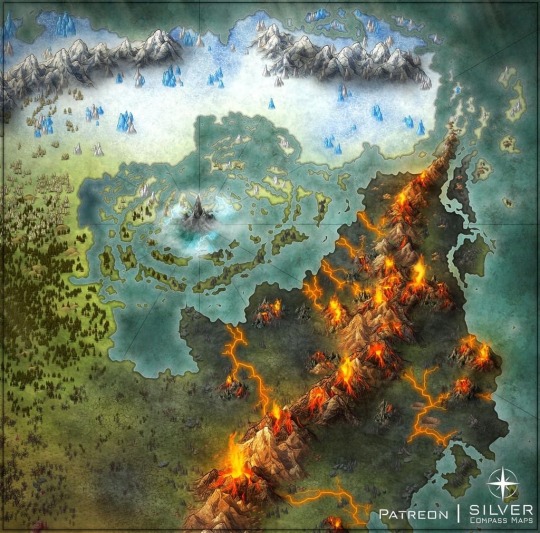
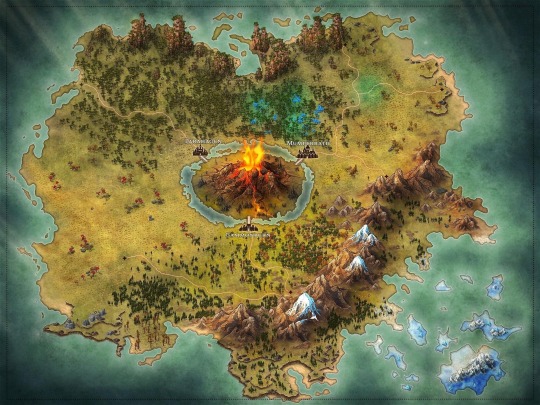


#d&d#dnd#pathfinder#tabletop#ttrpg#cartography#dndart#fantasy map#dndmap#dnd worldbuilding#worldbuilding#world map#fantasy world#dndworld#dnd 5e homebrew#5e homebrew
91 notes
·
View notes
Text
Ok so I just discovered what solarpunk is and OMG WHY AREN'T MORE PEOPLE TALKING ABOUT THIS!!! Like seriously it has got to be one of the best depictions of a utopian future I've ever seen and I am 100% using the aesthetic for the major city of my D&D world
68 notes
·
View notes
Text
Miscellaneous Worldbuilding Idea - Applying the Mandala to Fantasy
One aspect as someone who likes to study history and religion and politics that always fascinated me is the idea of the mandala political model.
The mandala (Sanskrit for "circle") is mostly used for art, but it is also used to describe the at-times interlocking spheres of influence powerful cities had in Southeast Asia before the 19th century.
The closer another polity, be it a tribe or other city or petty state was to a powerful city, the closer it was integrated into the system of that city, and the further away it was, the looser control generally became. Small polities would often have allegience to multiple regional centers, same with itenerant groups.
In fantasy settings, it's rather easy to apply.
A huge fortified city projects power along the established trade routes that go near by it. Rural communities rarely feel the power of the large city, but can occasionally call upon them for protection and have a useful market to send their goods to. They are politically however independent of that city with a hundred times it population.
The Orcish warband that migrates through the continent every year pays tribute to the big cities it comes close to, and in exchange the Orcs get access to the trade centers.
A remote forest is home to a religious community eager to avoid big city life. By not being close to any trade routes, either by sea or by land, officials of the city-states don't bother showing up.
The centrally-located island run by elves maintains ties with every coastal community, but several villages on the northern shore of the Great Ocean also swear fealty to the inland alliance of dwarven hillforts.
Basically, when worldbuilding, you can create interesting conflicts that come about by not following a "Westphalian" model of statehood, where areas are generally under the firm control of a single state entity. It even makes it harder to have modern nation states in your setting, allowing you to both explore fringe systems of government such as theocracies or anarchist communes without those polities having to function on a larger scale, and to have a clear focus on trade routes and diverse groups over all.
27 notes
·
View notes
Text
Intersex deity of the sun for my DnD campaign! They're unnamed at the moment but that's not going to stop be from drawing them 24/7
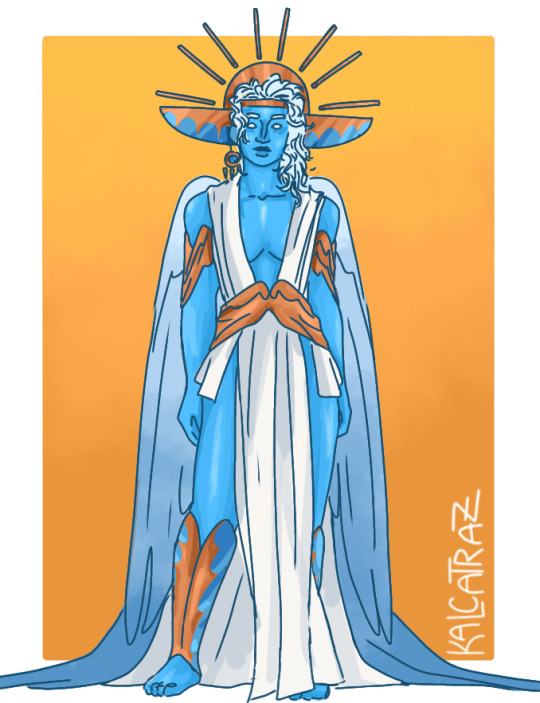
#worldbuilding#dnd worldbuilding#dnd#d&d art#art#d&d#dungeons and dragons#digital arwork#original character#d&d npc#intersex#lgbtqia#lgbtq#deity
8 notes
·
View notes
Text
making your own setting rules. i can just put vampires in this thing. i added a carnival. elves do ritual cannibalism. theres sentient weapons who can take humanoid shape. i made a berserk reference
23 notes
·
View notes